Brisket, a cornerstone of Texas barbecue, is a cut of beef that demands respect and understanding from pitmasters and home cooks alike. This comprehensive guide is designed to unravel the intricacies of brisket, from its deep-rooted heritage in Texan culture to the meticulous preparation techniques that can make or break its succulent flavor and tenderness. Whether you’re a seasoned chef, an aspiring griller, or a curious food enthusiast, this breakdown will equip you with the knowledge to select, prepare, and savor brisket like a true connoisseur. As we delve into the world of this beloved beef cut, we’ll explore the culinary aspects and the nutritional content, ensuring that your brisket experience is as informative as it is delicious. Join us on this flavorful journey as we dissect every facet of brisket, ensuring that your next barbecue is legendary.
About Brisket: The Texas Beef Cut
Brisket is the quintessential symbol of Texas barbecue, a testament to the state’s rich culinary heritage. Harvested from the cow’s lower chest, this cut embodies resilience, sourced from a region that sustains significant weight and is laced with robust connective tissue. The preparation and cooking of brisket are akin to fine art, demanding expertise to coax out its inherent tenderness and infuse it with the smoky, savory flavors that have garnered acclaim far beyond the borders of Texas.
More than a mere dish, brisket in Texas is a cultural touchstone, encapsulating the virtues of slow cooking and the communal joy of shared meals. It’s a staple at social celebrations, a highlight at competitive barbecues, and a symbol of the state’s storied tradition of meat smoking. This exploration into brisket delves into the heart of Texas’s culinary identity, celebrating a legacy steeped in patience, skill, and an unwavering commitment to quality.
For a deeper understanding of how to select, prepare, and enjoy brisket to its fullest, the following sections will guide you through the intricacies of this exceptional cut.
Brisket Fundamentals
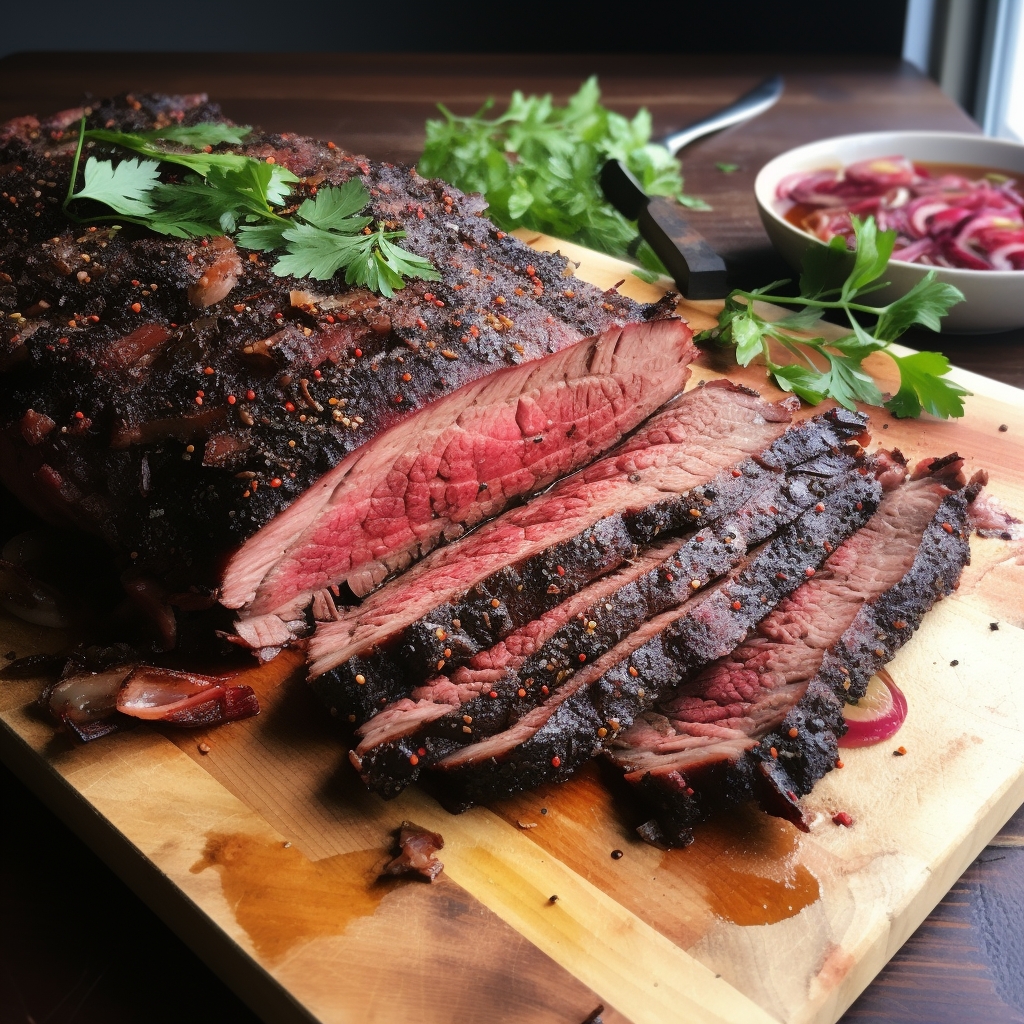
At the heart of every brisket is the story of its origin: the cow’s lower chest, where the pectoralis major and minor muscles bear the weight of the animal’s movements. This foundational cut, dense with collagen-rich connective tissue, is a marvel of flavor potential waiting to be unlocked.
The full brisket, or packer cut, can tip the scales at a hefty 8 to 20 pounds and is composed of two primary sections: the lean, even ‘flat’ and the marbled, succulent ‘point.’ The flat, often referred to as the first cut, is prized for its easy slicing, while the point, or second cut, is celebrated for its rich marbling and robust flavor profile. When subjected to the alchemy of slow cooking, this intricate weave of muscle and fat transforms into a mouthwatering delight.
Understanding the brisket’s complex structure is crucial, especially regarding the meat’s grain, which dictates tenderness and informs the slicing technique post-cooking. The flat’s grain runs consistently in one direction, whereas the point’s grain diverges, a detail essential for carving slices that are as visually appealing as delectable.
The secret to brisket’s legendary status lies in the low and slow cooking approach, which patiently breaks down the tough fibers and coaxes the connective tissue into melt-in-your-mouth gelatin. It’s this gradual flavor-building process that has cemented brisket as the centerpiece of Texas barbecue culture.
With these brisket fundamentals in mind, we set the stage for a deeper dive into the art of brisket mastery, from meticulous preparation to the subtleties of cooking that we’ll explore in future sections.
Brisket and Texas Tradition
In the heart of Texas, brisket transcends its culinary role, embodying the rich tapestry of the state’s heritage. The art of smoking brisket is a testament to the ingenuity of the Texan spirit, with roots stretching back to the days when cattle ranching was more than just a livelihood—it was a way of life. Initially overlooked by ranchers, the robust brisket cut found its worth through the smoke and spice of Central Texas’s German and Czech settlers. Their culinary alchemy turned a once-neglected cut into a sought-after feast.
The ascent of brisket within Texan culture is a story of innovation and tradition melding together. With their secret rubs and precise smoke blends, the state’s pitmasters have elevated the brisket to an art form. The mesquite and oak-infused smoke that envelops the meat is a signature of their craft. This process has garnered acclaim and sparked spirited competition at barbecue festivals throughout Texas.
Brisket also serves as a symbol of Texan hospitality and community. It’s the centerpiece of social gatherings, from backyard barbecues to grand celebrations, where the slow-cooked meat fosters camaraderie. The hours spent tending to the smoker become as much a part of the event as the meal itself, embodying the relaxed and communal ethos of Southern living.
Across the state, barbecue establishments showcase brisket as their crowning glory, each boasting a unique approach to mastering its preparation. The devotion to this cut is palpable in the meticulous care given to its cooking, the passionate debate it sparks among connoisseurs, and the pride woven into every slice served. Brisket in Texas is more than just sustenance—it’s a cherished tradition, a bond uniting communities, and an enduring element of the Texan identity.
Choosing the Best Brisket
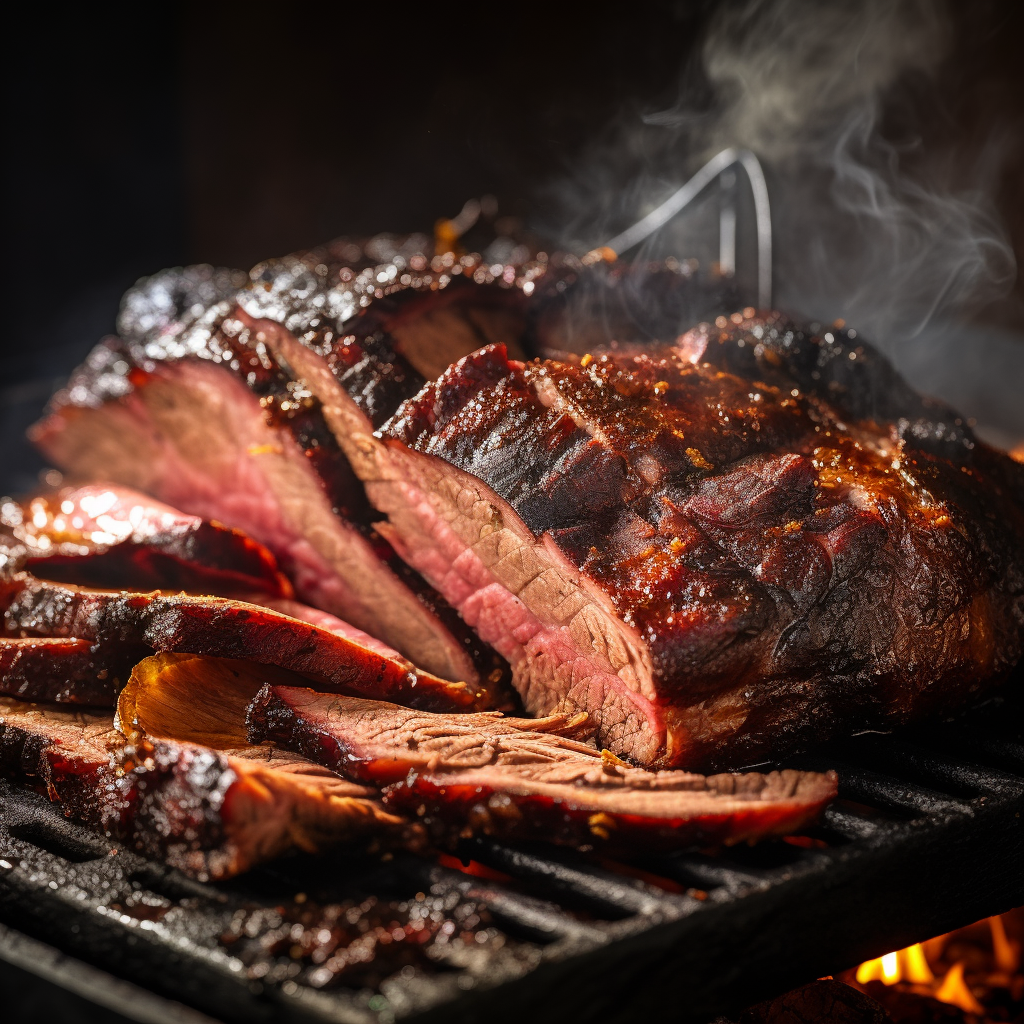
Embarking on the journey to select an exemplary brisket is a pivotal step toward culinary success. The ideal brisket harmonizes the lean flat with the more prosperous point, creating a balance essential for a succulent outcome. The presence of marbling, those delicate veins of fat meandering through the muscle, is paramount—these flecks of fat melt into the meat during cooking, imparting flavor and tenderness.
When assessing brisket, seek a creamy white marbling—a hallmark of a well-nourished animal. The fat cap, too, warrants attention; it should cloak the brisket with uniform thickness, neither too sparse to dry out the meat nor too thick to overwhelm the palate. Aim for a just right cap, about a quarter to a half-inch in depth.
Consider the brisket’s size, which should align with your culinary ambitions. A whole packer brisket offers both cuts and is the cut of choice for smoking, available in a range from more modest sizes suitable for intimate gatherings to heftier portions fit for a feast.
The brisket’s hue is also a telltale sign of its quality; look for a robust red color that speaks to its freshness. Steer clear of any brisket that looks faded or tinged with green, as these are indicators of subpar meat or improper handling.
Lastly, test the brisket’s pliability—a supple brisket suggests proper aging and a favorable amount of intramuscular fat, which promises a tender result once cooked.
In selecting your brisket, these considerations are not just details; they are the foundation upon which the ultimate brisket experience is built. With a discerning eye and an understanding of these key attributes, you’re well on your way to creating a memorable meal that honors the tradition of Texas barbecue.
Brisket Grades and Quality
Navigating the landscape of brisket quality begins with a grasp of the USDA’s grading system. This system, established by the United States Department of Agriculture, assesses beef based on marbling, maturity, and color, offering a dependable framework for discerning the caliber of your purchase.
USDA Prime is at the pinnacle of this hierarchy, distinguished by its generous marbling. This attribute is synonymous with a brisket that delivers exceptional tenderness, a succulent texture, and a rich flavor profile, typically reserved for gourmet establishments and specialty markets.
USDA Choice represents the middle ground, providing a moderate level of marbling. It’s a grade that harmonizes cost-effectiveness with commendable quality, making it a favored option among culinary enthusiasts and seasoned chefs.
On the more economical side, USDA Select brisket has minimal marbling, which may lead to a leaner cut. While this option is kinder to your wallet, it may necessitate more nuanced cooking techniques to achieve the desired softness.
While Prime, Choice, and Select are the most prevalent, other grades like USDA Commercial and Utility are generally reserved for processed meats and are not typically associated with brisket.
It’s also worth considering non-USDA factors that can influence brisket quality. Attributes such as grass-fed certification, organic labeling, or the prestige of specific breeds like Wagyu or Angus can also indicate a brisket’s excellence, even if they fall outside the traditional USDA grading scale.
By considering both the USDA grades and these additional markers of quality, you can tailor your brisket selection to your culinary ambitions, ensuring a match with your taste and texture preferences.
Responsible Sourcing from Texas
The quest for the quintessential brisket is about taste and the integrity of its source. In Texas, where beef is woven into the cultural fabric, selecting a brisket carries the weight of tradition and the responsibility of ethical stewardship.
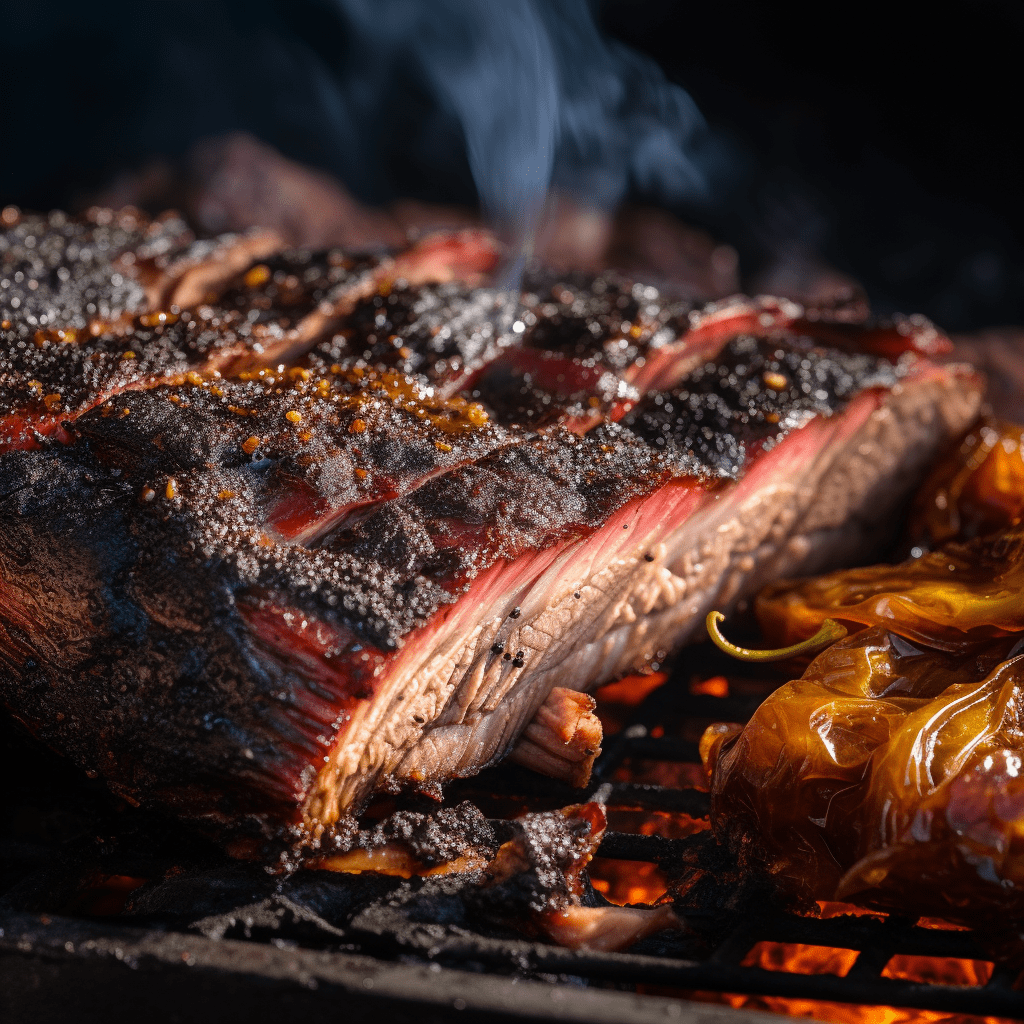
Texas’s reputation for premium beef is upheld by ranches committed to the welfare of their cattle. Look for suppliers who embrace the freedom of open-range grazing, uphold high animal nutrition and health standards, and employ stress-reducing handling techniques.
Environmental stewardship is another hallmark of responsible sourcing. Ranches that practice rotational grazing and protect native grasslands demonstrate a commitment to the land that sustains them. By supporting these practices, you’re not just savoring a delectable brisket; you’re contributing to the conservation of Texas’s unique ecosystems.
Transparency in beef production is increasingly important, with many Texas ranchers offering clear traceability from their fields to your fork. This level of openness assures the ethical origins of your meat.
Supporting local, family-run ranches in Texas fosters community and economic growth and often results in a superior product. These ranchers typically have a deep-rooted investment in their land and livestock, which can translate to a brisket of unparalleled quality.
In choosing responsibly sourced Texan brisket, you’re not just indulging in a culinary delight but upholding a legacy of quality, taste, and respect for the land and its inhabitants.
Preparing Brisket for Cooking
Embarking on the journey of cooking a brisket begins with meticulous preparation, an essential step to ensure the beef cut reaches its full potential in flavor and texture. Once you’ve chosen a brisket that meets the quality and ethical sourcing criteria, it’s time to focus on getting it ready for the heat.
Starting with the trimming process, the aim is to strike a balance by removing surplus fat, which allows for a uniform cook and deep flavor infusion. However, it’s crucial to maintain a consistent fat cap, typically about a quarter-inch thick, to safeguard the meat during the extensive cooking period.
Enhancing the brisket’s texture is also achievable at this stage. While some may opt for mechanical tenderization, the low-and-slow cooking method often will naturally break down the tough fibers, rendering additional tenderizing steps superfluous.
Seasoning is the final, pivotal step in preparation. A thoughtful application of spices, rubs, or marinades lays the foundation for a delectable flavor profile. The choice of seasonings, coupled with the technique and time of application, is instrumental in shaping the brisket’s ultimate taste.
Diligence in these preparatory steps is the secret to unlocking the quintessential Texas brisket experience, setting the stage for a culinary masterpiece as tender as it is tasty.
Trimming and Tenderizing
Mastering the nuances of trimming and tenderizing elevates the brisket from a simple cut of beef to a work of art. Trimming is not merely a cosmetic step; it’s a strategic move to ensure the meat cooks evenly and absorbs flavors thoroughly.
The art of trimming requires a careful hand to leave just the right amount of fat cap—about a quarter to a half-inch—on the brisket. This layer serves as a basting shield, melting gradually to baste the meat in flavorful juices. It’s also essential to remove the deckle, the more rigid fat that won’t render down, to avoid chewy patches.
Beneath the surface, the brisket may be sheathed in silver skin, a stubborn membrane that can impede the penetration of smoke and seasonings. Skillful removal of this layer is essential for achieving the full symphony of flavors that a well-seasoned brisket can offer.
While tenderizing methods vary, the brisket’s journey through a slow cook often softens its robust fibers. For those who prefer extra tenderness, a brief encounter with a tenderizing tool or a marinade containing natural enzymes can be considered. However, the brisket’s transformation during a patient, low-temperature cook typically negates the need for such interventions.
Through thoughtful trimming and an understanding of the brisket’s inherent qualities, cooks can ensure that this hearty cut reaches its pinnacle of tenderness and taste.
Seasoning for Flavor
The art of seasoning brisket is a pivotal step that shapes its ultimate taste profile. Seasoning choices span from the minimalist ‘Dalmatian rub’—a classic Texan mix of salt and pepper—to intricate blends that may incorporate elements like paprika, garlic, and onion powders and a hint of cayenne for heat.
Achieving a well-seasoned brisket begins with ensuring the entire surface is prepped for maximum spice adhesion. A slather of mustard, a brush of oil, or a dash of Worcestershire sauce can act as the perfect glue for your chosen dry rub or marinade.
While personal preference guides the selection of spices, even distribution is the cornerstone of developing a rich bark as the brisket cooks. Given the brisket’s heft, it can endure—and indeed, benefits from—a liberal seasoning. Salt, in particular, should be applied with a bold hand to draw out the meat’s inherent savoriness.
For those drawn to marinades, immersing the brisket well before cooking time allows the flavors to permeate deeply. A prolonged bath, ranging from several hours to overnight, will imbue the brisket with a more complex character.
Whether opting for a rub or a marinade, patience is key—allow the brisket to fully absorb the flavors before introducing it to the heat. Additionally, the choice of wood for smoking is an extension of seasoning, with various types imparting distinct smoky nuances to the brisket.
Skillful seasoning elevates the brisket to a gastronomic delight, setting the stage for the flavors to be gently unraveled during the slow cooking journey.
Cooking Techniques for Perfect Brisket
With your brisket now impeccably seasoned, it’s time to focus on the transformative cooking stage. The brisket’s dense connective tissues demand a gentle, unhurried approach to cooking—low and slow is the mantra for coaxing its tenderness and depth of flavor. Several methods are ready, each with a fervent following and subtle variations that can sway the final product.
Smoking is a quintessential Texas barbecue technique, where indirect heat and aromatic wood smoke collaborate to tenderize the meat. This method’s selection of wood, precise temperature control, and smoke flow are vital components. While preferences for wood types and smoker designs may vary, the essence lies in the extended cooking time at low heat to ensure a succulent brisket.
Alternatively, braising is favored for those seeking to marry their brisket with a savory sauce. This technique can be executed in an oven or a slow cooker, with the brisket partially immersed in a flavorful liquid and cooked leisurely until it becomes fork-tender.
No matter the chosen method, several variables require vigilant oversight: sustaining a steady temperature, preserving moisture to prevent the meat from drying out, and achieving the correct internal temperature for peak tenderness.
Each cooking strategy has the potential to yield a mouthwatering brisket brimming with flavor. However, they demand a meticulous eye for detail—a rewarding endeavor for culinary enthusiasts at any level of expertise.
Mastering the Smoker
Embarking on the journey to become a brisket aficionado involves a deep dive into the world of smoking meats. This revered technique, central to the heart of Texas barbecue, is a dance of heat, timing, and flavor.
Selecting the right wood is a pivotal first step in this culinary ballet. Each type of wood contributes uniquely to the brisket—hickory and oak infuse a bold smokiness, while fruitwoods like apple and cherry bestow a milder, sweeter kiss to the meat. With its potent earthy tones, Mesquite is a Texan favorite, though it must be used judiciously to prevent overpowering the brisket’s natural flavors.
The smoker’s temperature is the stage upon which your brisket will perform, and it must be set just right—usually between 225 and 275 degrees Fahrenheit. Managing this heat is an art, achieved by adjusting vents to control air flow. An overly zealous flame will sap the moisture from your meat, while insufficient heat will leave it tough and lacking.
Positioning the brisket on the smoker’s grate is a topic of lively debate: fat side up or down? The aim is to bathe the brisket evenly in heat and smoke, encouraging the formation of a ‘smoke ring’—that prized pink halo beneath the surface—and a rich bark.
The smoking process is a marathon, not a sprint, often extending beyond 12 hours. Consistency is your ally during this time. Resist the urge to peek too often, as each opening of the smoker can lead to heat loss and uneven cooking.
A trusty meat thermometer will guide you to determine when the brisket has reached its peak, with an internal temperature between 195 and 205 degrees Fahrenheit signaling completion. The ‘probe test’—feeling for a buttery resistance when inserting a skewer—confirms that your brisket is ready to be heralded as a masterpiece.
With each brisket comes a new understanding, and through the careful orchestration of temperature and smoke, you’ll find yourself ever closer to achieving the zenith of smoked brisket excellence.
Braising for Tenderness
Braising brisket is akin to a slow dance, where patience and gentle heat coax the meat into sublime tenderness. This method bathes the brisket in a flavorful liquid, allowing it to surrender its toughness slowly in exchange for succulence.
Begin by preheating your oven or preparing your slow cooker, setting the stage at around 300 degrees Fahrenheit for the former. The brisket is seared until it boasts a golden-brown crust, sealing in its juices and setting the stage for a flavor-packed journey.
The next act features aromatic vegetables—onions, carrots, celery, and garlic—sautéed to build a flavorful base. The seared brisket rejoins the ensemble, surrounded by these fragrant companions, before being anointed with the chosen braising liquid. This could be a rich broth, a bold wine, a hearty beer, or a tangy tomato sauce, each adding its own narrative to the brisket’s flavor story.
The liquid’s level is crucial—it should reach halfway up the brisket, providing moisture without causing the meat to boil. Herbs and spices join the mix, weaving their notes into the aromatic tapestry. With the lid secured, the brisket is left to braise tenderly, transforming under the alchemy of low heat and steam.
In the oven, this process unfolds over several hours, while a slow cooker offers a more hands-off approach, with the brisket reaching peak tenderness after 8-10 hours on low or 4-6 hours on high. As the brisket bathes, its connective tissues relent, melting into gelatin that enriches the meat with moisture and flavor.
To finish, the braising liquid can be refined into a sumptuous sauce, skimming off any excess fat and reducing it to the desired consistency. Drizzled over the sliced brisket, the final flourish elevates the dish to a memorable culinary experience.
Through braising, the brisket is not only tenderized but also imbued with deep, layered flavors, resulting in a dish that’s as rich in taste as it is in tradition.
After Cooking: Resting and Slicing
The brisket’s odyssey reaches its zenith not when the heat subsides but during the crucial phases of resting and slicing. These steps are paramount, ensuring that the care invested in cooking is reflected in every succulent slice served.
Resting is more than a pause; it’s a transformative period for the brisket. As it rests, loosely tented with foil to retain warmth, the internal juices meander back through the fibers, ensuring each mouthful will be lusciously moist. The length of this interlude varies, typically spanning from half an hour to over an hour for larger specimens, and it is a testament to the adage that good things come to those who wait.
When the moment to slice arrives, precision is key. The brisket boasts a duo of muscles, each with its unique grain pattern. Slicing against the grain is not merely a suggestion—it’s a requisite for tenderness. With a keen eye to discern the grain’s path and a sharp knife in hand, aim for uniform slices, about a quarter-inch in thickness, to elevate the dining experience. This careful approach preserves the bark’s crispness and the meat’s succulent texture, making each bite a testament to the art of brisket preparation.
Why Resting Matters
The significance of resting a brisket cannot be overstated—it’s the bridge between robust flavor and supreme tenderness. Post-cooking, the brisket harbors a reservoir of juices at its core due to the heat’s relentless push during the cooking process. Without proper rest, these juices would escape upon slicing, leaving behind a less impressive cut.
As the brisket rests, the fibers that contracted under the heat’s intensity begin to relax, welcoming back the juices into their midst. This not only enhances juiciness but also allows for carryover cooking to finish the brisket to perfection gently. The rest of the period, mirroring the brisket’s cooking duration is a small investment for a significant return in quality.
For those larger or more robust cuts, wrapping the brisket in foil and a towel, then placing it in a cooler, can extend the resting phase without sacrificing warmth. This technique ensures that every fiber is optimally relaxed, ready to yield the most tender and flavorful brisket possible. Skipping this step would be a disservice to the brisket, robbing it of its potential to be both good and truly exceptional.
Slicing to Perfection
The art of carving a brisket is as crucial as its preparation. The fibers of the brisket, now tender from the cooking process, require a delicate touch to preserve their succulence. A razor-sharp knife is indispensable, ensuring each slice is clean and precise. A dull blade might mangle the fibers, compromising the brisket’s texture.
To achieve the quintessential brisket slice, one must slice against the grain. This technique involves cutting perpendicular to the muscle fibers, shortening them for a more tender bite. The brisket comprises two distinct sections: the leaner flat and the fattier point, each with its unique grain pattern. Discerning the juncture of these sections is crucial, and it’s often advisable to separate them before slicing to navigate the different textures with ease.
The ideal thickness for brisket slices is roughly 1/4-inch, striking the perfect balance between structural integrity and chewability. It’s also wise to slice only what you’ll serve immediately, as the remaining unsliced brisket will retain moisture better, aiding in preservation and subsequent reheating.
For a visually appealing presentation, arrange the slices neatly on a serving platter, allowing the smoke ring and bark to take center stage. This delights the eye and invites guests to select their preferred cuts, from lean to lusciously fatty.
In essence, meticulous slicing is a testament to the care invested in the brisket’s preparation, enhancing the dining experience by ensuring the meat’s texture, flavor, and tenderness are celebrated in every morsel.
Storing and Reheating Brisket Without Loss of Quality
Preserving the integrity of brisket for future enjoyment hinges on adept storage and reheating techniques. One must approach storage with precision to safeguard the brisket’s moisture and robust flavor after the initial feast.
It’s advantageous to keep the brisket intact or in large chunks when storing, as smaller pieces are prone to drying out. Envelop the meat in foil or plastic wrap before placing it in an airtight container or bag, thus shielding it from the air that accelerates spoilage. In the refrigerator, a brisket treated in this manner can remain detectable for a few days.
For extended storage, freezing is a viable option. Double-wrap the brisket to fortify it against freezer burn and tuck it into a freezer bag. While it can be stored for months, the brisket is at its best when consumed sooner rather than later.
When it comes to reheating, the objective is to warm the brisket without sapping its juiciness. An oven set to a low temperature, around 325 degrees Fahrenheit, with the brisket wrapped in foil and accompanied by a splash of broth or its juices, can help retain its moisture. Alternatively, a slow cooker on a low setting can mimic the moist heat that brisket favors.
Regardless of the reheating method—be it oven, slow cooker, sous-vide, or even microwave with a damp paper towel—the aim is to heat the brisket to the perfect temperature without further cooking. This careful balance ensures that the brisket remains as succulent and flavorful as when it first emerged from the smoker or oven.
By mastering the nuances of storage and reheating, brisket transforms from a mere single-event delicacy to a culinary gift that continues to give, offering exceptional taste and quality even days after its initial unveiling.
Storage Best Practices
Ensuring your brisket maintains its succulence after cooking hinges on proper storage techniques. Begin by letting the brisket reach room temperature to prevent raising your refrigerator’s internal temperature, which could affect other stored food. Keeping the brisket intact or in substantial pieces is advisable, as this reduces surface exposure and helps retain moisture.
Wrap your brisket securely in plastic wrap or aluminum foil, creating a barrier against moisture loss. Then, for an added layer of protection, place it in a sealed container or a heavy-duty resealable bag. This dual-protection strategy is crucial for safeguarding the brisket from air exposure and bacterial growth, thus preserving its delectable taste and extending its lifespan.
Position the brisket in the refrigerator’s rear, where the temperature is most stable and cold, to mitigate the effects of the door’s frequent opening and closing. If you’re looking to store the brisket for an extended period, freezing is your best bet. Envelop the meat in plastic wrap, add a foil layer, and then tuck it into a freezer bag, expelling excess air before sealing. Remember to mark the bag with the storage date. When properly wrapped, your brisket can be frozen for several months, ensuring that when it’s time to thaw, it remains as flavorful as the day it was cooked.
To thaw, transfer the brisket to the refrigerator at least a day before reheating. This gradual process helps the meat retain its moisture and texture. By following these storage guidelines, you can rest assured that your brisket will be just as enjoyable when serving it again.
Optimal Reheating Methods
Reheating brisket is an art that, when done correctly, can restore the meat’s original tenderness and flavor. The key is to apply heat gently and evenly, ensuring the brisket is warmed without losing its juiciness. There are a few methods that excel in achieving this balance.
For oven reheating, preheat to 325 degrees Fahrenheit for a gentle warm-up. Place the brisket in a baking dish, introduce a splash of broth or its juices, and tightly cover with foil. This method creates a steamy environment that rehydrates the meat as it heats. The brisket typically requires about half an hour to reach the ideal temperature, though this can vary with size.
Alternatively, a slow cooker can serve as an excellent vessel for reheating. Set it to low and add the brisket with liquid to prevent drying. This method allows for a gradual increase in temperature, ensuring the meat remains moist throughout the process.
For those with a penchant for precision, sous-vide is a superior choice. Seal the brisket with a small amount of liquid in a vacuum bag and immerse it in a water bath pre-set to your brisket’s ideal serving temperature. This method ensures even heating without the threat of overcooking.
If time is of the essence, microwaving can be effective if done carefully. Place sliced brisket in a microwave-safe dish, cover with a moist paper towel to promote steam, and heat on medium power in short bursts. This method requires vigilance to avoid overheating.
Whichever method you choose, aim for an internal temperature of 145 degrees Fahrenheit to ensure the brisket is heated through but not overcooked. These reheating techniques are designed to replicate the brisket’s original cooking environment closely, promising a second serving nearly as satisfying as the first.
The Nutritional Aspects of Brisket
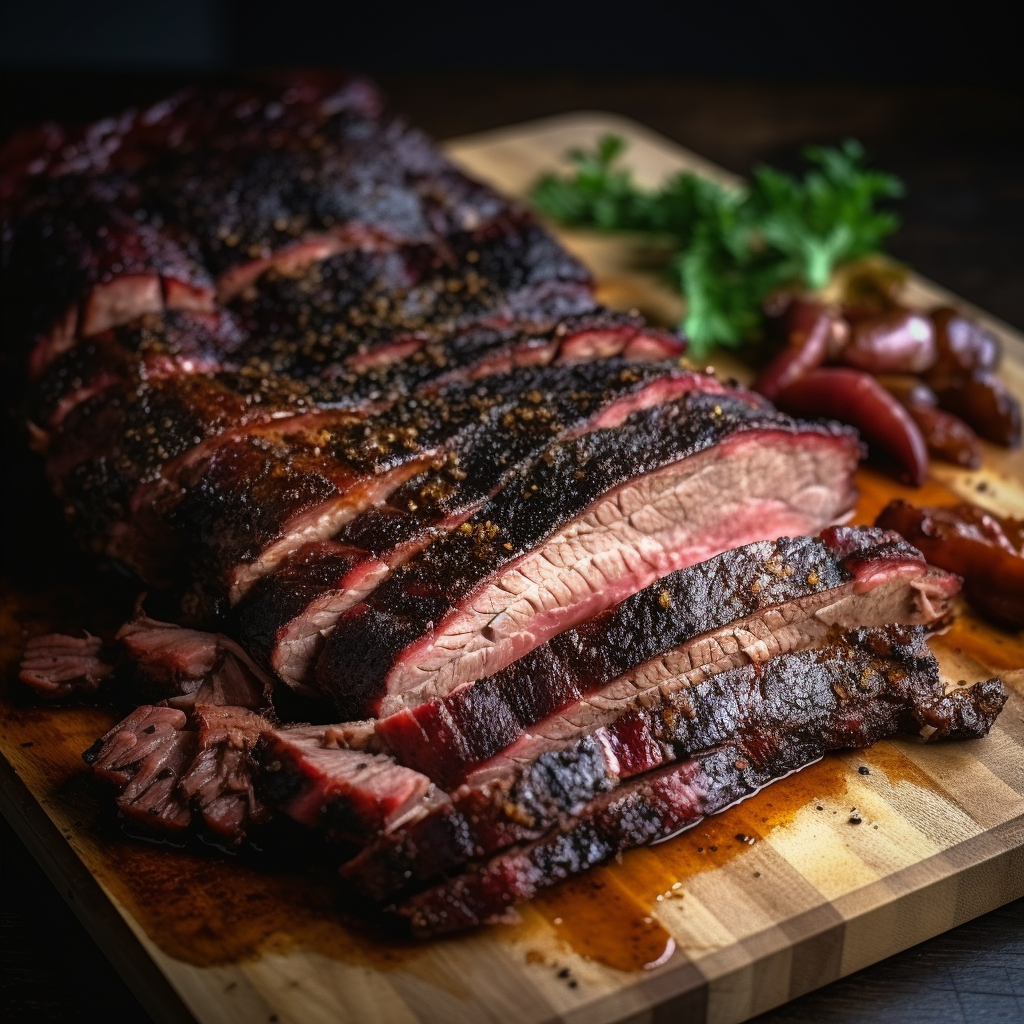
Delving into the nutritional composition of brisket reveals a wealth of benefits and considerations for those mindful of their dietary intake. This robust cut from the cow’s lower chest is packed with protein, an essential building block for muscle repair and overall bodily health. Brisket also serves as a hearty source of iron, a key element in blood oxygenation, and zinc, an immune system defender. B vitamins, particularly B12, support neurological health and are indispensable for red blood cell formation.
Yet, it’s important to note that brisket’s richness comes with higher fat content, particularly in the point cut known for its succulent marbling and generous fat cap. While these fats contribute to the cut’s mouthwatering flavor and tenderness, they also add to the calorie count. They are a source of saturated fats, best enjoyed in moderation to maintain heart health.
The leaner flat cut offers a lower fat option for those seeking balance, and portion control is key. Complementing brisket with fibrous vegetables and whole grains can enhance the meal’s nutritional profile, promoting a more heart-friendly dining experience. By understanding brisket’s nutritional landscape, enthusiasts can savor this Texan staple in a way that aligns with a balanced and thoughtful diet.
Brisket: A Nutritional Overview
Brisket boasts a rich array of nutrients, making it a substantial addition to any meal. Beyond its impressive protein content, indispensable for muscle health and repair, brisket is a treasure trove of minerals such as selenium and phosphorus. It also provides a suite of vitamins, including niacin, vitamin B6, and the all-important B12, essential for nerve health and DNA synthesis.
The fat profile of brisket includes both saturated and monounsaturated fats—the latter being akin to the heart-healthy fats in olive oil. While saturated fats necessitate mindful consumption, the monounsaturated variety can be a boon for heart health when eaten in moderation.
Cooking methods can also sway the nutritional value of brisket. Techniques that involve heavy use of oils or sugary sauces can inflate the calorie and fat content while opting for spice-based rubs and trimming excess fat before cooking can help maintain nutritional balance.
Calorically, a lean portion of brisket typically ranges between 300 to 400 calories for a 3.5-ounce serving. Awareness of these nutritional facts is crucial for integrating brisket into their diet without compromising health objectives.
Brisket can be a flavorful and nutritious component of a meal, provided it is prepared thoughtfully and consumed within the framework of a balanced diet. With a comprehensive understanding of its nutritional profile, brisket can be enjoyed responsibly, contributing to a diverse and health-conscious menu.
Enjoying Brisket in Moderation
Savoring a well-prepared brisket’s rich, deep flavors is one of life’s pleasures, yet it’s important to enjoy such indulgences judiciously. A mindful approach to consuming this delectable cut ensures you can relish its taste without overstepping the boundaries of a healthful diet.
Portion control is paramount when it comes to moderation. Even with brisket’s high protein content, it’s wise to limit servings to maintain balance. A sensible portion is comparable to the size of a deck of cards, translating to about 3-4 ounces of meat, which can be surprisingly satisfying.
To create a well-rounded meal, pair your brisket with sides that are abundant in nutrients. Imagine the synergy of a tender slice of brisket alongside a crisp, colorful salad or a medley of roasted vegetables. These additions not only enhance the meal with fiber and essential nutrients but also help offset the meat’s richness.
At a barbecue, where temptation abounds, embrace the pleasure of variety. Tasting small portions of diverse offerings can be as gratifying as a heaping brisket plate and allows for a more nutrient-diverse experience.
Consider reserving brisket for special occasions, elevating it to a culinary highlight. This practice not only curbs the frequency of consumption but also preserves the anticipation and enjoyment associated with festive meals.
By integrating these mindful eating strategies, brisket aficionados can maintain their appreciation for this Texan favorite while adhering to a balanced and thoughtful diet.

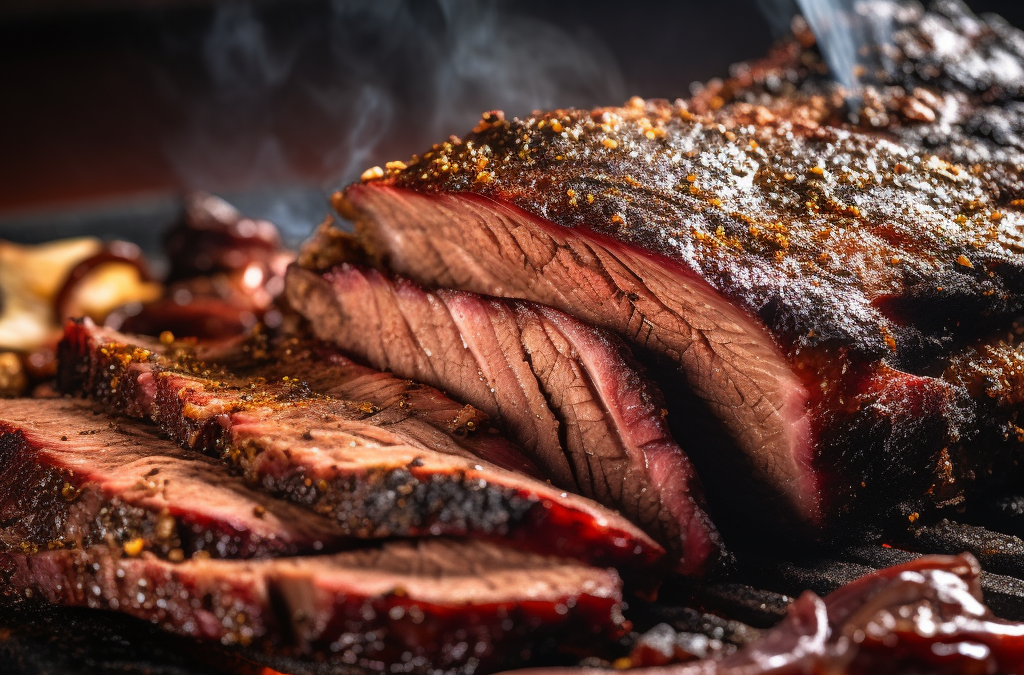

This is an awesome guide thanks.
A smoked brisket sandwich has been my favorite since I was little boy.
The best brisket is a Texas Brisket.
Thank you for this article I was able to answer some questions I had for cooking brisket. Bob Hines.